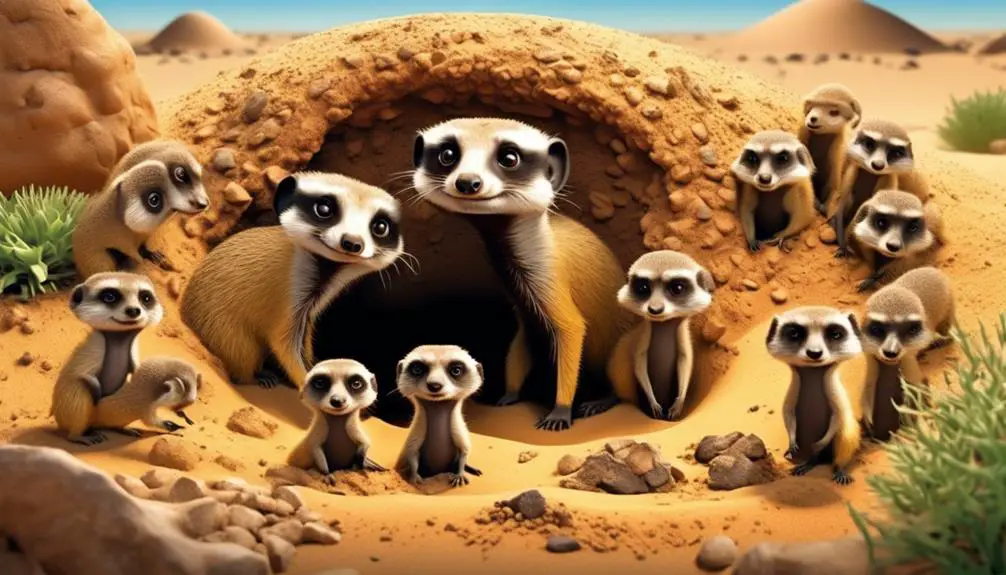Have you ever marveled at the intricate tunnels and burrows that lie concealed beneath your feet, like a secret labyrinth waiting to be unveiled?
These hidden passageways, crafted by the tireless paws and beaks of animals that dig holes, hold a world of wonder and fascination. From the elusive burrowing owls to the industrious digger bees and wasps, these creatures display remarkable engineering skills and survival strategies that will leave you in awe.
But it doesn’t stop there. Join us on this journey as we uncover the hidden lives of rabbits, voles, bilbies, raccoons, groundhogs, skunks, moles, and pocket gophers, and discover the vital role they play in shaping our ecosystems.
Get ready to unearth the secrets of these incredible diggers, as we reveal stunning pictures that will transport you to their subterranean realm.
Burrowing Owls
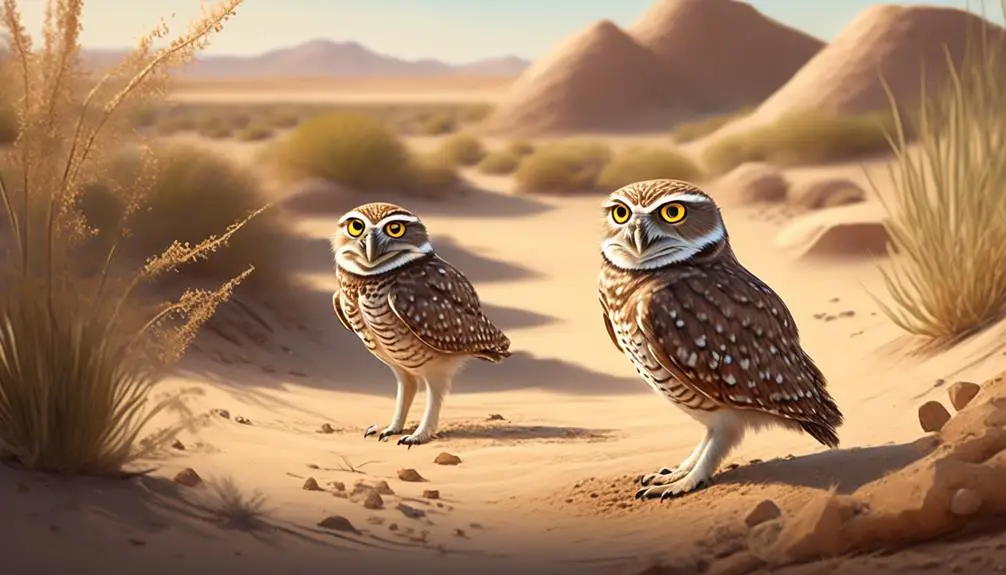
Burrowing Owls, unlike most owls, are active during the day and burrow their heads in the ground for protection. These small, fascinating creatures are known for their unique behavior and adaptations. In their burrows, Burrowing Owls create a safe haven from predators and harsh weather conditions. Their burrows consist of a vertical tunnel with multiple chambers, providing them with ample space to rest, raise their young, and store food. The owls meticulously maintain their burrows, removing debris and ensuring the entrance remains concealed.
Burrowing Owls have a distinctive call that resembles the sound of a rattlesnake when they feel threatened. This vocalization, combined with their ability to burrow and camouflage themselves, serves as a deterrent to potential predators. Their diet consists mainly of insects, small mammals, and reptiles, which they capture by swooping down from their perches or hunting near their burrows. These owls are skilled hunters, using their exceptional vision and hearing to locate their prey.
Observing Burrowing Owls in their natural habitat provides a glimpse into their fascinating behavior and adaptations. Their ability to thrive in environments where other owls may struggle is a testament to their resilience and resourcefulness. By studying their burrowing habits and unique vocalizations, researchers can gain valuable insights into the ecology and behavior of these remarkable birds.
Insects
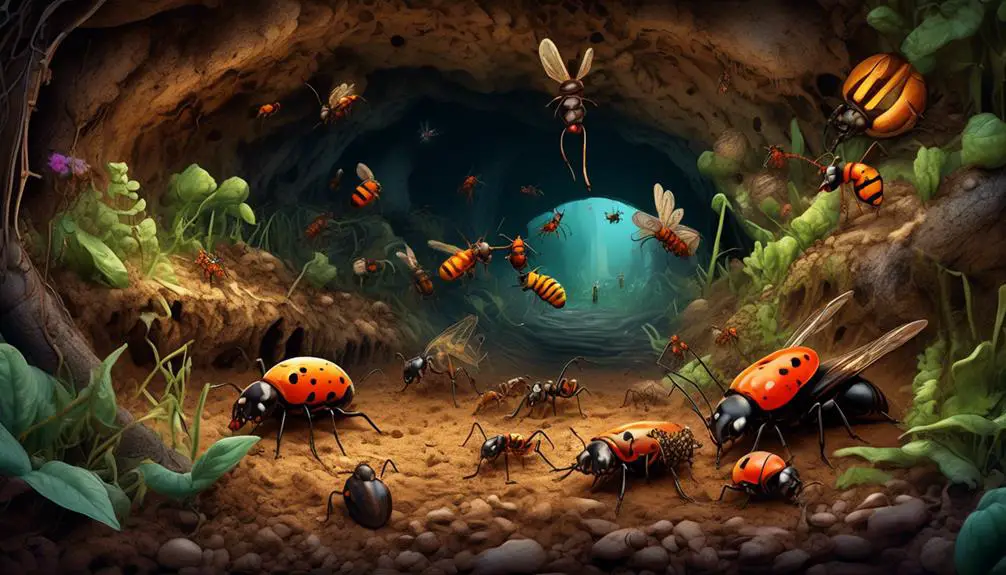
Insects, with their remarkable adaptations and diverse species, play a vital role in the underground ecosystem. Many insect species have evolved to live primarily underground, utilizing various strategies to burrow in the earth. Wasps and spiders, for example, have adapted their bodies to dig through soil and create intricate tunnels. Bees, on the other hand, make nests in the soil instead of trees, constructing underground chambers for their colonies.
These underground habitats provide insects with protection from predators and extreme weather conditions. By living underground, insects can avoid potential threats and maintain a stable environment for their survival. Furthermore, the soil provides insects with a rich source of food and shelter. They can feed on decaying organic matter, plant roots, and other insects that inhabit the underground ecosystem.
Insects also contribute to the health of the soil by promoting decomposition and nutrient cycling. Their activities help break down organic matter, releasing essential nutrients that enrich the soil. Additionally, their burrowing actions enhance soil aeration and water infiltration, improving overall soil quality and fertility.
The underground world of insects is a complex and fascinating ecosystem. From the humble earthworm to the industrious digger bee, these creatures play a significant role in maintaining the balance and functionality of the underground environment. Understanding and appreciating the contributions of insects to the underground ecosystem is crucial for the preservation of this intricate web of life.
Rabbits
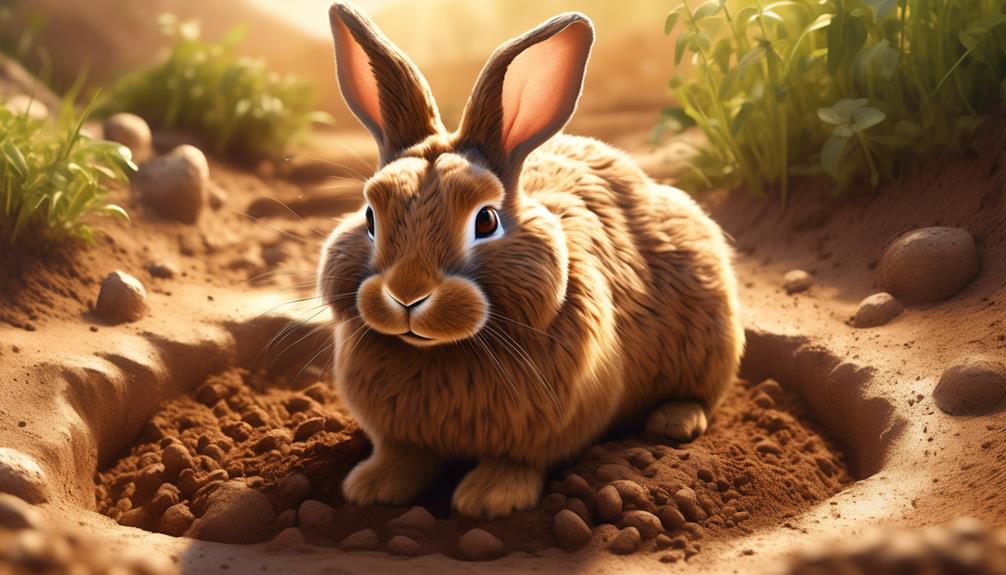
Rabbits, known for their ability to burrow, create intricate tunnels for safety and security. These underground networks serve as a refuge from predators and provide camouflage for these small mammals. Rabbits are meticulous in their tunnel construction, ensuring multiple exit points for quick escape. Their burrows are a testament to their engineering skills, with interconnected chambers and passageways.
The intricate tunnel systems of rabbits not only offer them protection but also serve as a safe haven for their young. The burrows are carefully constructed to control temperature, keeping the interior cool in the summer and warm in the winter. These underground dwellings are an essential part of a rabbit’s survival strategy, allowing them to thrive in a variety of habitats.
Next in the article, we will explore the subtopic of voles and their remarkable burrowing abilities. Stay tuned for more fascinating insights into the world of animals that dig holes.
Voles
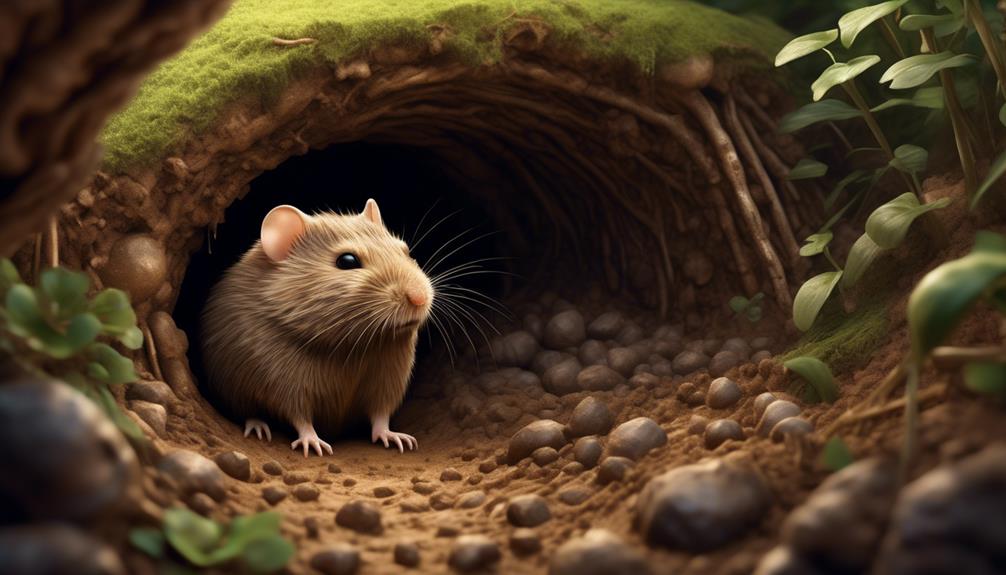
Voles, small rodents known for their exceptional burrowing abilities, intricately dig holes for protection during the winter months and to store food for survival. These tiny creatures, measuring around 5-8 inches in length, create an extensive network of tunnels just below the surface of the ground. The entrances to their burrows are often concealed by grass or vegetation, making them difficult to detect.
Voles construct their burrows with great precision, using their sharp incisors and powerful forelimbs to excavate the soil. They create multiple chambers within their burrows, each serving a specific purpose. One chamber is used for nesting and raising their young, while others are designated for storing food. The voles gather seeds, nuts, and vegetation during the warmer months and stockpile them in their underground larders. This food cache ensures their survival during the harsh winter when food is scarce.
The tunnels themselves are narrow and winding, providing protection from predators such as owls, foxes, and snakes. Voles are intelligent engineers, constructing their burrows to include various escape routes and hidden exits. The intricate tunnel system also helps regulate temperature and humidity, maintaining a cozy and comfortable environment for the voles throughout the year.
Bilbies
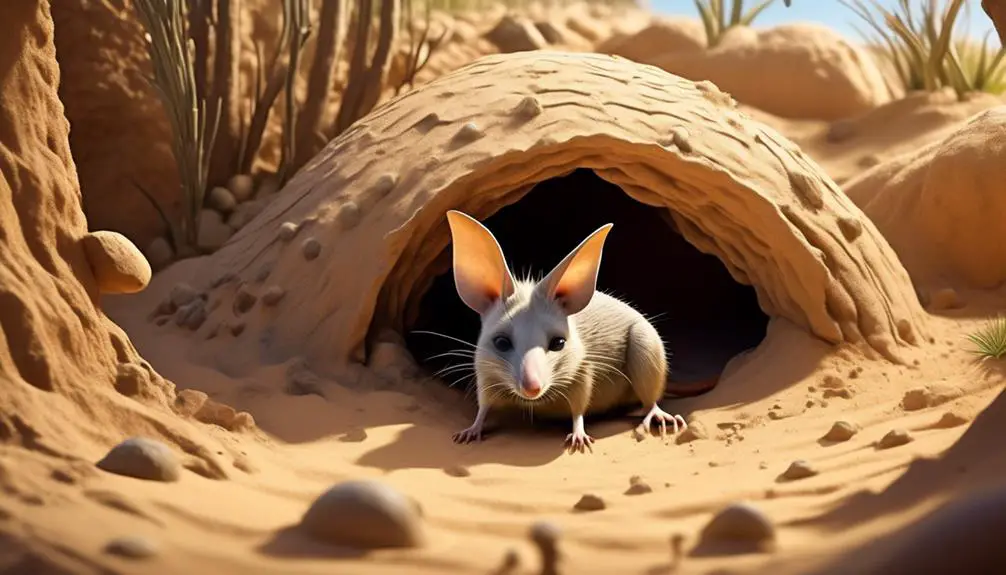
Bilbies possess impressive burrowing skills, constructing intricate tunnel networks that can reach depths of up to 10 feet.
Their tunnels are uniquely spiral-shaped, a design that enhances protection against potential predators.
These small creatures exhibit remarkable engineering abilities, showcasing their adaptability to their underground habitats.
Impressive Burrowing Skills
With their impressive engineering skills, Bilbies demonstrate remarkable burrowing abilities that rival those of other animals. These small marsupials are known for their intricate tunnel networks, which can reach depths of up to 10 feet. The burrows are spiral-shaped, providing protection against predators by making it difficult for them to navigate.
The entrance of the burrow is typically hidden, further enhancing their safety. Bilbies are meticulous diggers, using their strong claws and snouts to excavate the soil. Their burrows serve as a place to rest, raise their young, and store food.
These impressive burrowing skills not only provide shelter and protection for Bilbies, but also contribute to the overall health of their ecosystem by aerating the soil and promoting nutrient cycling.
Spiral-Shaped Tunnel Networks
Bilbies, with their impressive burrowing skills, create intricate spiral-shaped tunnel networks that provide them with protection and safety from predators. These small marsupials, known for their engineering prowess, construct burrows that can reach depths of up to 10 feet.
The spiral-shaped tunnels aren’t only visually striking but also serve a functional purpose. By creating a maze-like network, bilbies are able to confuse and deter potential predators, making it difficult for them to locate the burrow entrance. This design also allows for multiple escape routes, ensuring the bilbies have a means of evading danger.
The spiral tunnels provide a safe haven for these remarkable creatures, shielding them from the threats of the outside world and allowing them to thrive in their subterranean sanctuary.
Meerkats

Meerkats, known for their highly organized and intricate underground systems, construct complex burrows with multiple entrances to ensure the safety and survival of their colony. These burrows serve as a central hub for meerkat activity, providing protection from the harsh desert environment and offering a secure space for raising their young.
Meerkat burrows are a marvel of engineering, exhibiting a sophisticated level of planning and construction. The tunnels are carefully designed to have several levels, which helps to regulate temperature and provide refuge from predators such as hyenas. The entrances are strategically placed, allowing for quick escape routes and ensuring that the meerkats always have a lookout on the surface.
Inside the burrows, different chambers serve different purposes. There are designated sleeping areas, nurseries for the young, and even latrines to maintain cleanliness. The meerkats meticulously maintain their burrows, constantly digging and repairing any damage to ensure the integrity of their complex underground system.
Meerkat burrows aren’t only functional but also social hubs. They provide a gathering place for the meerkats to socialize, communicate, and establish group cohesion. The burrows also offer protection from extreme weather conditions, such as scorching heat or freezing cold, allowing the meerkats to survive in their harsh desert habitat.
Prairie Dogs
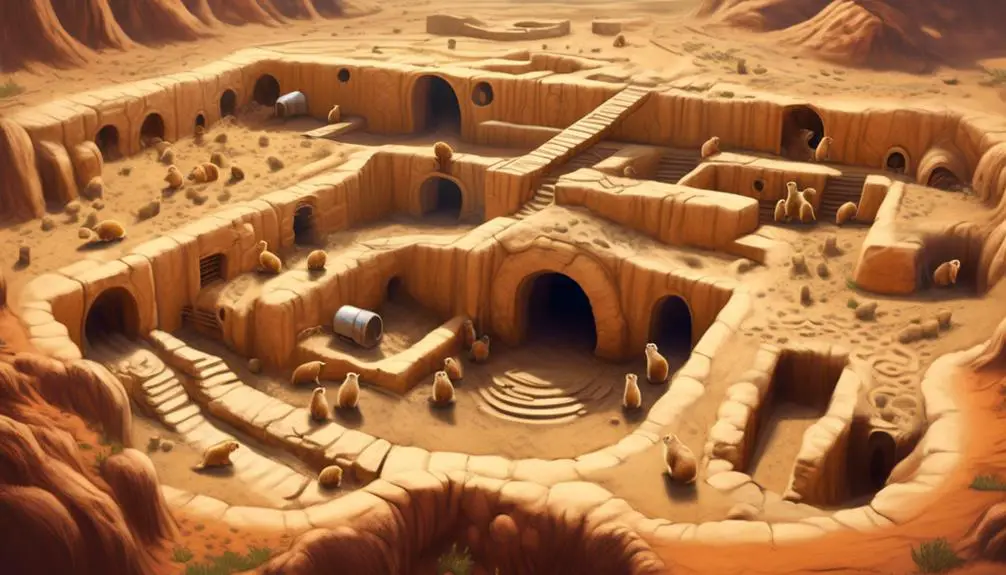
Prairie dogs, highly social and burrowing rodents native to North America, construct intricate tunnel systems that serve as their homes, providing them with shelter, protection, and a complex network of interconnected chambers. These tunnel systems are a marvel of engineering, with entrance holes leading to a labyrinth of underground passages.
The burrows of prairie dogs can reach impressive depths of up to 10 feet, allowing them to escape from predators like coyotes and hawks. The tunnels also serve as a means of temperature regulation, providing cooler temperatures during hot summers and warmer temperatures during cold winters.
Within these tunnel systems, prairie dogs create specialized chambers for different needs. They have nurseries for raising their young, as well as chambers for storing food and escaping extreme weather conditions. The interconnected nature of their burrows allows for easy communication and social interaction among the prairie dog community.
Prairie dogs are meticulous in their burrowing habits, carefully excavating the soil and using it to reinforce the walls of their tunnels. These rodents are known for their efficient digging skills, allowing them to create and maintain their complex underground dwellings.
Badgers

Badgers, known for their impressive digging abilities and intricate networks of tunnels, create burrows for safety and protection from predators. These medium-sized mammals belong to the family Mustelidae and are characterized by their stocky bodies, short legs, and strong forelimbs adapted for digging. Badgers are highly skilled diggers, capable of excavating burrows in various terrains, including grasslands, woodlands, and even urban areas. Their burrows, also known as setts, consist of a complex network of tunnels and chambers that serve multiple purposes.
| Burrow Structure | Function | Observations |
|---|---|---|
| Main Tunnel | Entry and exit point | The main tunnel provides easy access to the burrow and serves as the primary route for badgers to enter and exit their underground home. |
| Sleeping Chamber | Resting and sleeping | The sleeping chamber is a cozy space where badgers retreat to rest and sleep during the day. It is often lined with grass, leaves, and other soft materials for added comfort. |
| Food Storage Area | Storing food provisions | Badgers are opportunistic omnivores and will store surplus food in designated chambers within their burrow. This allows them to have a readily available food source during times of scarcity. |
| Nursery Chamber | Raising young | Female badgers create nursery chambers to raise their cubs. These chambers are typically located deeper within the burrow and provide a safe and secluded environment for the young badgers to grow and develop. |
Badgers’ burrows not only serve as a refuge from predators but also provide protection from harsh weather conditions. The intricate tunnel systems help regulate temperature and humidity, creating a stable microclimate within the burrow. Additionally, badgers’ burrows have been known to extend beneath manmade structures such as buildings, roads, and fences, showcasing their impressive digging capabilities.
Earthworms

Earthworms, commonly found in soil ecosystems, play a crucial role in enhancing soil fertility and promoting overall ecosystem health. These small, slender creatures are a vital component of the soil food web. Earthworms burrow through the soil, ingesting organic matter and breaking it down into smaller particles. As they digest this material, they excrete nutrient-rich castings, or worm poop, which enriches the soil with essential nutrients like nitrogen, phosphorus, and potassium. This process, known as vermicomposting, helps to improve soil structure, increase water retention, and enhance nutrient availability for plants.
Earthworms are incredibly efficient at their job. They have the ability to move underground with a force up to ten times their body weight, thanks to their muscular bodies and slimy secretions. Their burrowing activities also help to aerate the soil, allowing oxygen to reach plant roots and facilitating the decomposition of organic matter. Furthermore, the tunnels created by earthworms promote water drainage, reducing the risk of soil erosion and waterlogging.
In addition to their role in soil fertility, earthworms also contribute to weed control. They consume weed seeds, preventing them from germinating and reducing weed competition in agricultural and garden settings.
Raccoons
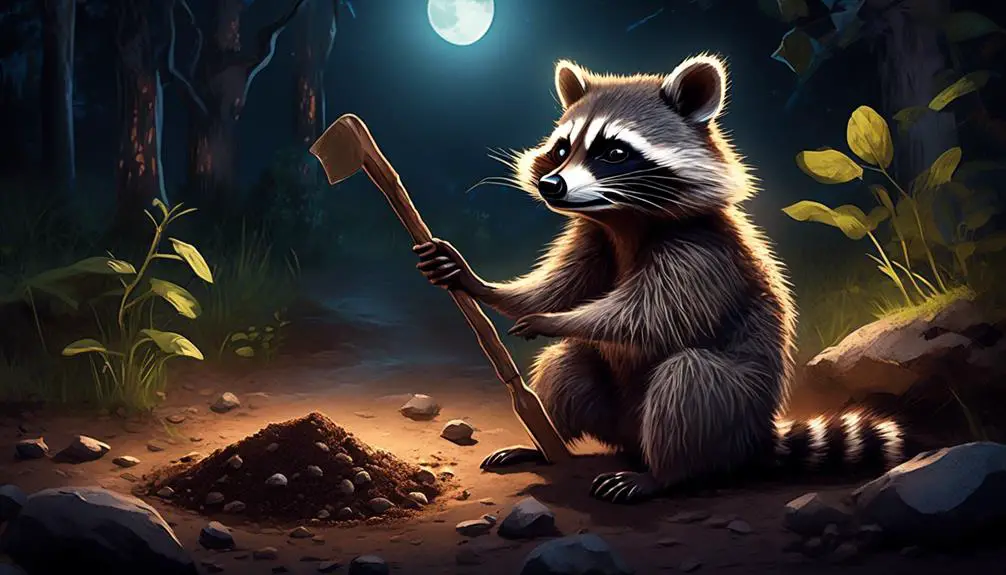
Raccoons, highly adaptable and resourceful creatures, are known for their expert climbing, swimming, and digging abilities. These intelligent mammals use their nimble paws and sharp claws to excavate holes in search of food. With their keen sense of smell, raccoons can detect the presence of earthworms, insects, and other small creatures beneath the ground. Once they locate their potential meal, they skillfully dig into the soil, using their front paws to scoop out the dirt and create a hole.
Raccoons are clever and creative in their digging techniques, often employing a combination of scratching, pawing, and scooping movements to access their desired prey. Their dexterity allows them to swiftly and efficiently dig through the earth, leaving behind neat and well-defined holes. These holes serve as evidence of the raccoon’s resourcefulness and persistence in obtaining the sustenance they need.
Whether it’s foraging for food or creating a den for shelter, raccoons demonstrate their remarkable digging abilities as they navigate the subterranean world beneath our feet.
Groundhogs
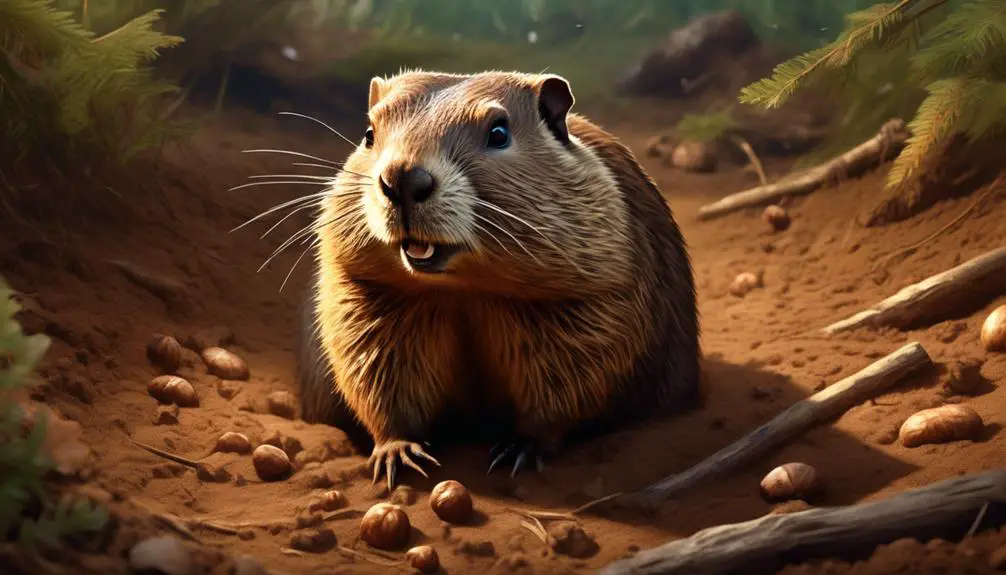
Groundhogs, also known as woodchucks, are skilled burrowers that construct intricate underground dwellings. Their burrows serve multiple purposes, providing shelter, hibernation quarters, and a safe environment for raising their young.
The design and construction of groundhog burrows demonstrate their ability to create structures that offer thorough protection from the weather and potential predators.
Burrow Design and Construction
With a meticulous attention to detail and a remarkable engineering prowess, the groundhog constructs an elaborate burrow system for shelter, hibernation, and raising its young.
Groundhogs, also known as woodchucks, are expert diggers, capable of creating intricate underground dwellings. These burrows are designed with thorough protection from the weather, featuring multiple chambers for different purposes.
The main entrance is typically located on a slope to prevent flooding, while the tunnels can extend up to six feet below the surface. Groundhogs use their strong claws and powerful jaws to excavate the soil, creating a network of interconnected tunnels.
These burrows not only provide shelter and safety from predators, but they also serve as hibernation chambers during the winter months. The groundhog’s burrow design and construction showcase their adaptability and survival instincts in their natural habitat.
Groundhog Behavior and Habits
Groundhogs exhibit fascinating behavioral patterns and habits that contribute to their survival and success in their natural environment. These creatures, also known as woodchucks, are diurnal and spend a significant amount of time outside their burrows during the day.
They’re herbivorous and primarily feed on grasses, leaves, and other vegetation. Groundhogs are skilled diggers and construct elaborate burrow systems that serve as their shelters, hibernation dens, and nurseries for raising their young.
These burrows are meticulously designed with multiple entrances and chambers, providing thorough protection from the elements and predators. Groundhogs are also known for their ability to predict the weather, as they emerge from their burrows in early February to determine the arrival of spring.
Their behaviors and habits make them highly adaptable and successful in their underground habitats.
Importance of Groundhog Burrows
The intricate network of burrows constructed by groundhogs serves a vital purpose in their survival and ecosystem. Groundhog burrows, also known as dens, provide shelter, hibernation sites, and safe spaces for raising young.
These burrows are meticulously designed to offer thorough protection from the elements. The entrances are strategically positioned to avoid exposure to harsh weather conditions, while the burrows themselves are deep and well-insulated to maintain a stable temperature.
Additionally, groundhog burrows have multiple chambers, serving different functions such as sleeping, eating, and waste disposal. The interconnected tunnels also allow for quick escape routes from predators.
Moreover, groundhog burrows provide habitat for other animals, such as skunks and rabbits, who may take advantage of abandoned or unused portions of the burrow system.
Skunks
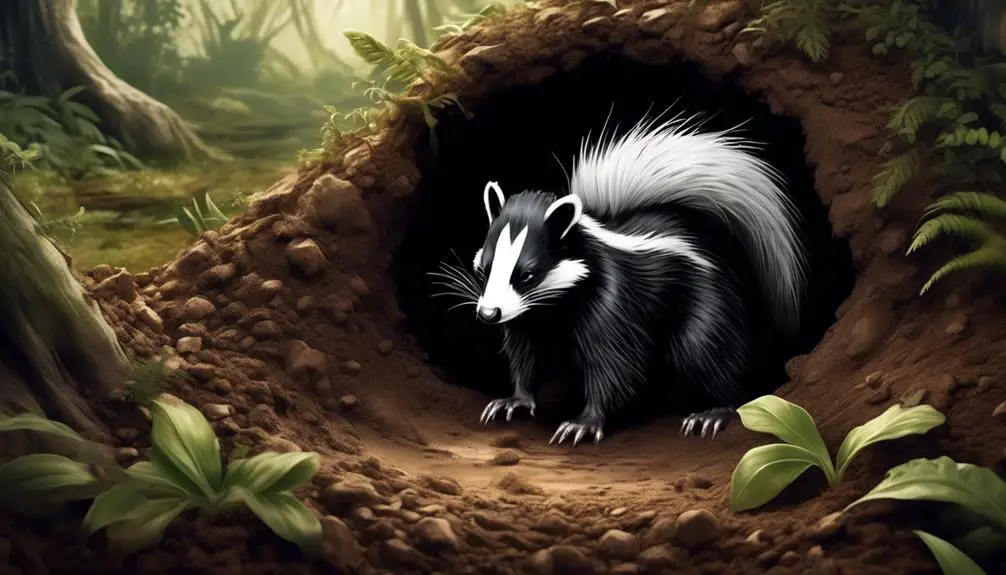
Skunks, known for their distinctive black and white fur, are adept diggers who create holes in search of insect larvae and worms. These nocturnal creatures possess strong forelimbs and long claws, which enable them to excavate the ground with ease. Skunks use their keen sense of smell to locate their prey, digging into the soil to reach the tasty morsels hidden beneath. Their holes can vary in size, depending on the depth at which the insects or worms are found.
Skunks are known to create tunnels that can disrupt yards, as they move from one location to another in search of food. However, they don’t stay in one place for long, as they’re constantly on the lookout for more permanent residences.
Skunks play a vital role in the ecosystem by controlling populations of harmful insects and worms. Their digging behavior not only benefits them but also contributes to the overall health of the environment.
Moles and Pocket Gophers
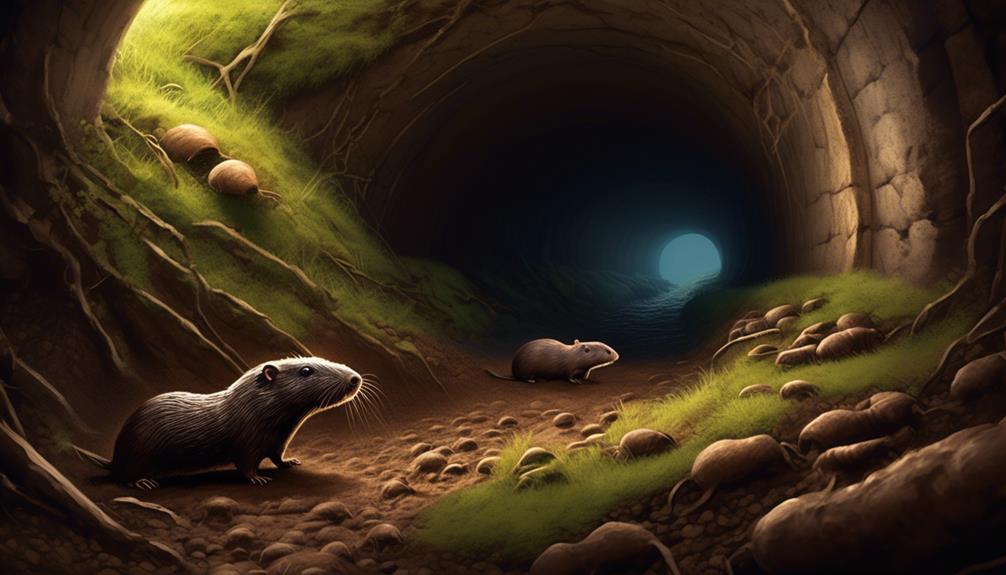
As we continue our exploration of animals that dig holes, let’s now turn our attention to the fascinating creatures known as moles and pocket gophers.
Moles, with their velvety fur and strong forelimbs, are talented and efficient diggers. They possess specialized adaptations such as powerful claws and a cylindrical body that allows them to maneuver through the soil with ease. In fact, a mole can construct a tunnel up to 18 feet long in just one hour. These tunnels serve as their underground highways, providing them with protection and access to their prey, which primarily consists of earthworms, insects, and grubs.
On the other hand, pocket gophers, found throughout North America, are renowned for their tireless digging abilities. Equipped with powerful claws and teeth, they can create and fill in tunnels quickly. These industrious rodents build extensive underground burrows, reaching lengths of up to five meters. They meticulously bury the entrance of their tunnels with dirt, creating mounds that are characteristic of their presence.
Both moles and pocket gophers play important roles in their ecosystems. By loosening the soil and creating tunnels, they enhance soil aeration and nutrient distribution. Additionally, their burrows provide shelter for other small animals, and their activities can even aid in water drainage.

Erzsebet Frey (Eli Frey) is an ecologist and online entrepreneur with a Master of Science in Ecology from the University of Belgrade. Originally from Serbia, she has lived in Sri Lanka since 2017. Eli has worked internationally in countries like Oman, Brazil, Germany, and Sri Lanka. In 2018, she expanded into SEO and blogging, completing courses from UC Davis and Edinburgh. Eli has founded multiple websites focused on biology, ecology, environmental science, sustainable and simple living, and outdoor activities. She enjoys creating nature and simple living videos on YouTube and participates in speleology, diving, and hiking.
🌿 Explore the Wild Side!
Discover eBooks, guides, templates and stylish wildlife-themed T-shirts, notebooks, scrunchies, bandanas, and tote bags. Perfect for nature lovers and wildlife enthusiasts!
Visit My Shop →
